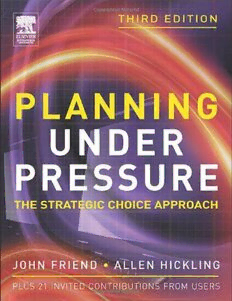
Planning Under Pressure PDF
Preview Planning Under Pressure
Planning Under Pressure DEDICATION to MARI (Friend) and JUDITH (Hickling) whosetolerance,inspirationandsupporthavebeensoimportanttousoverall theyearswhilewehavebeenworkingonsuccessiveeditionsofthisbook. Theytoohavehadtoplanunderpressureinmanagingthework/lifebalances oftheirowncreativecareers,andinmeetingtheever-changingdemandsof ourgrowingfamilieswhilewehavesooftenbeenabsentorpreoccupied. JohnFriend AllenHickling Planning Under Pressure The Strategic Choice Approach Third edition John Friend Sheffield, UK Allen Hickling Warwickshire, UK Plus a new chapter containing invited contributions from 21 users AMSTERDAM•BOSTON•HEIDELBERG•LONDON•NEWYORK•OXFORD PARIS•SANDIEGO•SANFRANCISCO•SINGAPORE•SYDNEY•TOKYO ElsevierButterworth-Heinemann LinacreHouse,JordanHill,OxfordOX28DP 30CorporateDrive,Burlington,MA01803 Firstpublished1987 Secondedition1997 Thirdedition2005 Copyright©2005,JohnFriendandAllenHickling.Allrightsreserved TherightofJohnFriendandAllenHicklingtobeidentifiedastheauthorsofthiswork hasbeenassertedinaccordancewiththeCopyright,Designsand PatentsAct1988 Nopartofthispublicationmaybereproducedinanymaterialform(including photocopyingorstoringinanymediumbyelectronicmeansandwhether ornottransientlyorincidentallytosomeotheruseofthispublication)without thewrittenpermissionofthecopyrightholderexceptinaccordancewiththe provisionsoftheCopyright,DesignsandPatentsAct1988orunderthetermsof alicenceissuedbytheCopyrightLicensingAgencyLtd,90TottenhamCourtRoad, London,EnglandW1T4LP.Applicationsforthecopyrightholder’swritten permissiontoreproduceanypartofthispublicationshouldbeaddressed tothepublisher. PermissionsmaybesoughtdirectlyfromElsevier’sScienceandTechnologyRights DepartmentinOxford,UK:phone:(cid:1)+44(cid:2)(0)1865843830;fax:(cid:1)+44(cid:2)(0)1865853333; e-mail:permissions@elsevier.co.uk.Youmayalsocompleteyourrequeston-lineviathe Elsevierhomepage(http://www.elsevier.com),byselecting‘CustomerSupport’ andthen‘ObtainingPermissions’. BritishLibraryCataloguinginPublicationData AcataloguerecordforthisbookisavailablefromtheBritishLibrary LibraryofCongressCataloguinginPublicationData AcataloguerecordforthisbookisavailablefromtheLibraryofCongress ISBN 0750663731 ForinformationonallElsevierButterworth-Heinemannpublications visitourwebsiteathttp://books.elsevier.com TypesetbyIntegraSoftwareServicesPvt.Ltd,Pondicherry,India www.integra-india.com PrintedandboundinGreatBritain Working together to grow libraries in developing countries www.elsevier.com | www.bookaid.org | www.sabre.org Contents Authors’prefacetothethirdedition vii Forewordtothethirdedition ix Authors’prefacetothesecondedition xi Authors’prefacetothefirstedition xv Forewordtothefirstedition xix Aquickaccessguide xxi 1 Foundations 1 2 Workingintoproblems 23 3 Workingtowardsdecisions 43 4 Orientations 67 5 Skillsinshaping 89 6 Skillsindesigning 119 7 Skillsincomparing 147 8 Skillsinchoosing 179 9 Practicalities 211 10 Theelectronicresource 245 11 Extensionsinprocessmanagement 257 12 Invention,transformationandinterpretation 273 13 Learningfromothers By21invitedcontributors:seeoverleaffornames 295 14 Thedevelopmentalchallenge 361 Accesstofurtherinformation 369 Bibliography 373 Index 379 v List of Contributors to Chapter 13 13.1 JonathanRosenhead,LondonSchoolofEconomics,UK 298 13.2 KnutStrömberg,ChalmersUniversity,Sweden Jaan-HenrikKain,ChalmersUniversity,Sweden 303 13.3 FransEvers,EnvironmentalPolicyDirector,TheNetherlands 308 13.4 RichardOrmerod,WarwickBusinessSchool,UK 312 13.5 ArnoldvanderValk,WageningenUniversity,TheNetherlands GerritJanCarsjens,WageningenUniversity,TheNetherlands 315 13.6 DaveFriend,SoftwareDesignConsultant,WestYorkshire,UK 319 13.7 AlessandroGiangrande,UniversitàRomaTre,Italy ElenaMortola,UniversitàRomaTre,Italy 322 13.8 RebeccaHerron,UniversityofLincoln,UK DennisFinlayson,InternationalDevelopmentConsultant,UK 327 13.9 RichardHarris,IndependentProcessConsultant,UK 331 13.10 RobAngell,EnvironmentalPolicyConsultantandFacilitator,UK 336 13.11 MikeCushman,LondonSchoolofEconomics,UK AlbertoFranco,WarwickBusinessSchool,Coventry,UK 340 13.12 ElisendaVila,PlanningConsultant,Venezuela AnaMariaBenaiges,PlanningConsultant,Venezuela 345 13.13 BrendanHickling,IndependentFacilitatorandMediator,UK 349 13.14 JackiePhahlamohlaka,RuralEducationPioneer,SouthAfrica 353 13.15 LenyBregman,EnvironmentalProjectManager,TheNetherlands 357 vi Authors’ preface to the third edition In 1996, when we drafted our authors’ preface to the second edition of this book, we would havebeenverysurprisedbyanysuggestionthatwemightfindourselvesagaininvitedtocome togethertoproduceathirdeditionintheearlyyearsofthetwenty-firstcentury. Weare,ofcourse,delightedthatinterestinthestrategicchoiceapproachanditsapplications hascontinuedtogrow,spreadingtonewpartsoftheworldandnewgenerationsasfreshareas ofapplicationcontinuetoemerge.Sowewelcometheopportunitytoaddsomenewcontent, andtoreviewthewayinwhichwehadpresentedourconceptsandmethodsinearliereditions. Both of us have now passed normal retiring age, and have started to limit our commitments accordingly. So the question arose: were we ourselves necessarily the ones who should be writingaboutthesenewdevelopments?Orshouldwenowinviteotherstojoinusinpresenting the learning points arising from their recent experiences, and speculating about what further developmentsthenextfewdecadeswillbring? CONTRIBUTIONS FROM OTHERS Finallyweagreedtoinviteseveralofourmorerecentassociates,andalsosomewhomwehave known for many years, to make short contributions to a new chapter, entitled Learning from Others. Fifteen contributions in all are brought together in our new Chapter 13. They present theviewsoftwenty-oneauthorsandco-authors,abouthalfofthemfromourowncountryand halffromotherpartsoftheworld.Amongthekeypointsthatcomethrougharethefollowing: • It is both possible and worthwhile to be inventive in combining the methods presented in thisbookwithcomplementarymethodsofinteractiveworkingfromothertoolboxes–andto reflectdeeplyontheoutcomessothatlessonsfromtheseexperiencescanbewidelyshared; • The guidelines to the management of extensive projects offered in Chapter 11 offer new andpracticalsolutionstothedevelopmentofagreedpositionsinimportantfieldsofnational andindeedtrans-nationalpolicy.Thishasbeendemonstratednotleastintheimportantand complexdomainofenvironmentalpolicy,whichdifferentstakeholderstendtoapproachfrom opposingandsometimesdeeplyentrenchedpositions; • In parallel, the potential has now been widely demonstrated for introducing the principles andmethodsoftheStrategicChoiceApproachquicklyandinformallyintomoreinformaland localised arenas of decision-making such as community development, urban regeneration andruralcapacity-building,wheremanifoldexternalpolicyinfluencescanimpingeinintricate andunpredictableways; • It is a matter for celebration rather than concern that several people who have found the Strategic Choice Approach helpful in their own worlds of decision-making have introduced interpretationsandtransformationsoftheirown,toincreaseitsacceptabilityinthevarious decision-makingculturesinwhichtheywork. vii Authors’prefacetothethirdedition OTHER CHANGES To pave the way for the new multi-authored Chapter 13, we have made some adaptations to the coverage of the two newer Chapters 10 and 11 that we added in our second edition. Chapter10reflectstheexperiencesofJohnFriendindevelopingsoftwaretosupportstrategic choicesincethefirsteditionappeared,whileChapter11reflectsAllenHickling’sexperiencesin adaptingtheapproachtothemanagementofextensiveprojects.Also,wehaveinsertedalinking chapter – Chapter 12 – in which we take stock of the variety of changes in presentation and terminology that have been introduced by other people – and sometimes by ourselves. Each chapter from 11 onwards begins with a synopsis in bold typeface, to highlight its contribution tothisedition. After the introduction of the twenty-one new voices in Chapter 13, we return in our closing Chapter14tolookafreshatthedevelopmentalchallengethatwasposedinthefinalchapterof oursecondedition–recognisingthattheworldarounduscontinuestochangeinwaystowhich weandoursuccessorsmustlearntofashionresponsesinpracticalyetcreativeways. In general, the additions in this new edition have been more concerned with developments in practice than in theory. Co-incidentally, however, the international journal Planning Theory is publishing a special issue (Volume 3, No. 3, November 2004; Mandelbaum, ed.) just as our neweditionappears,inwhichfoursetsofinvitedcontributorsfromEuropeandNorthAmerica present appreciations of the contributions of our work to the development of planning theory. All these papers emphasise our uniquely close link with planning practice, and the issue ends withaninvitedresponsefromJohnFriend. A COMPANION WEBSITE Advances in technology, since our second edition appeared, now offer a new solution to the familiarchallengeofkeepingthecontentofanybooksuchasthisoneuptodate.Thecompanion websitethatourpublishershavemadeavailableforPlanningunderPressurehasbeendesigned notonlyforusebystudents,butalsoasaforuminwhichabroaderdialoguewithusers,research- ersandconsultantscanbeallowedtodevelopinaflexible,spontaneousandsustainableway. Weshallhavetoseehowthisnewchanneldevelops;allwecandonowistodoourbesttogive itaflyingstart.Thewebreferenceishttp://books.elsevier.com/companions/0750663731. A NEW FOREWORD We could think of nobody more appropriate to invite to write a short foreword for this third editionthanArnolddeJong,ourlong-standingDutchassociatewhohasworkedalongsideuson many assignments in Europe and who, through his extensive facilitation practice, has demon- strated repeatedly how the skills and methods presented in this book can generate additional confidence and wider support for important development decisions at local, regional, national and international levels. Our hope is that his example will be followed by many talented and inventiveyoungerpeopleasournewtwenty-firstcenturyunfolds. JohnFriend AllenHickling April2004 viii Foreword to the third edition Throughoutmy45-yearworkinglife,whichspannedsuccessivecareersasanagriculturalengin- eer, a corporate information manager, a senior local politician and a decision process consult- ant, I have had an ever-increasing concern for interactive participation processes. In spite of widespread criticism that they are not effective, it has always been my belief – backed by my experience–that,skilfullymanagedandfacilitated,theoppositeistrue. Overmylasttwodecadesasaconsultant,facilitatorandtrainer,StrategicChoicehasplayed a central and indeed a guiding role. So I can confirm from long experience that not only does it offer a fresh and relevant approach to complex management and planning tasks in theory; it also delivers in practice. It does so at many levels from that of enhancing democratic action in local communities to that of consensual policy development in the European Union. It has no parallelinbuildingagreementbetweenseeminglyopposedstakeholdergroupsacrossnational and disciplinary frontiers, and across those between the government, business and voluntary sectors. In the mid-1970s, I was becoming drawn into the intricacies of local politics from my position as Alderman of the municipality of Arnhem in The Netherlands, with the portfolio of TownPlanningandUrbanRenewal.Issuesofparticipationanddemocraticprocessinplanning werethencomingstronglytothefore,andwewerelookingfornewideastohelpusturnthem intoreality.In1976,IledavisitingteamfromArnhemonavisittotheofficesoftheInstitutefor OperationalResearchinCoventry,havingheardoftheirinnovatoryapproachandtheinfluence itwasstartingtohaveonpublicplanningintheUK. This first meeting with John Friend and his colleagues of the ‘IOR School’ was to mark a turningpointinmyprofessionalcareer.Then,from1980,throughthe1980sand1990s,Ihadthe privilegeofworkingcloselywithAllenHickling.Webecameimmersed,jointlyandseparately,in asuccessionofdemandingprojectstotackledauntingissuesofenvironmental,economicand social policy, in each case working interactively with as many of the stakeholders as possible. Evidenceofwhathasnowbeenachievedwillbefoundscatteredthroughoutthepagesofthis book.InparticularitwillbefoundinthenewChapter13whichbringstogethercontributionsfrom peopleinmanycountrieswhohaverecentlybeenextendingthefrontiersofStrategicChoicein newandpromisingdirections.Frommytwenty-firstcenturyretirementhomeinAthens,Ilook back on more than two decades in which the philosophy and methods of the Strategic Choice approachhaveprovidedthecentralthreadofmyconsultingcareer,helpingtoturntheidealsof democraticplanningintoreality. PlanningunderPressureisnotatheoreticalstudy.Frommy20yearsworkingasafacilitator usingtheconceptsofstrategicchoice,Icanwitnesstothepracticalvalueofthisbook.Thefact thatitnowappearsinathirdedition,withmanynewcontributions,holdsmuchpromiseforthe decadesahead. ArnolddeJong DecisionProcessConsultantandFacilitator April2004 ix
